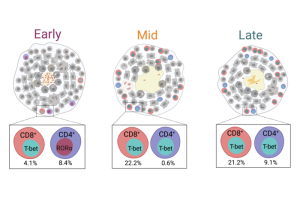The immune response against tuberculosis (TB) infections develops at least twice as slowly as that triggered by other infectious diseases that affect the lungs. A study in non-human primates by University of Pittsburgh School of Medicine immunologists has now found that the adaptive immune response against the pathogenic Mycobacterium tuberculosis (Mtb) bacteria that cause TB matures over time. The results showed that the first subset of infection-fighting T lymphocytes does not become fully active until three months after the infection, and the emergence of a second subset of T cells at five months post-infection can contribute to bacterial clearance and recovery.
This delayed adaptive immune response partially explains why TB infections easily take hold in the host’s lungs, and suggests that vaccination strategies against TB should be adjusted to prime T cell responses and kick them into gear at the early stages of infection, to help quickly eliminate the pathogenic bacteria.
“Our work highlighted the timing of evolving adaptive immune response and bacterial clearance in TB,” said Nicole Grant, PhD, postdoctoral fellow at Pitt. “Harnessing that knowledge to increase the number of functional T cells in the early days of infection and getting them to respond and contain bacterial growth quicker is key to creating a therapy that can shut down the infection at its onset.” Grant is first author of the team’s published paper in Cell Reports, titled, “T cell transcription factor expression evolves over time in granulomas from Mycobacterium tuberculosis-infected cynomolgus macaques,” in which they concluded, “This study highlights the evolution of T cell responses within lung granulomas, suggesting that vaccines promoting the development and migration of T-bet+ T cells would enhance mycobacterial control.”

While TB is relatively uncommon in the United States it remains a major concern in many countries around the world, disproportionately affecting people in developing countries, and killing more people worldwide than HIV/AIDS. “Mtb, the causative agent of TB, is a global health concern, yearly resulting in 10 million new cases of active TB,” the author wrote.
TB is a severe respiratory disease caused by bacteria that slowly propagate and expand upon entering the lungs through the airways, causing lung scarring and inflammation, severe cough, and chest pain. To wall off the growing bacteria, the body responds by creating cellular barriers called granulomas, which form as organized spheres of cell clusters made up of immune cells that are a tell-tale sign of TB.
But as the authors noted, “Despite extensive research, the immunological contributors to bacterial control in granulomas are not well understood … Understanding the process of bacterial restriction and containment in lung TB granulomas is critical for identifying new targets for vaccines and therapeutics.”
Most people without underlying health conditions can control TB infections and remain asymptomatic without medical assistance, but those with weakened immune systems, such as people with HIV/AIDS or those sick with COVID-19, are at high risk of developing complications and succumbing to the disease.
The only widely used vaccine against TB, called the bacille Calmette-Guérin (BCG) vaccine, is administered to newborns within the first few hours of life. However, the BCG vaccine is limited in its effectiveness and does not prevent infections in the lungs. Senior author JoAnne Flynn, PhD, distinguished professor of microbiology and molecular genetics at the University of Pittsburgh, further noted, “Lung TB infections can start with a single bacterium that divides into hundreds of thousands of bacteria over the course of four to six weeks,” said “Not a lot of bacterial killing happens between then and 10 weeks post-infection. In our study, we wanted to find out what changes in the lung immune environment over time that allows it to eventually bring TB infection under control.”

Flynn’s previous work showed that administering the BCG vaccine intravenously, as opposed to traditional injection under the skin, offers nearly complete protection against TB infections in monkeys. The newly reported study in Cell Reports provides additional insights into how this vaccine strategy might be working by speeding up the T cell responses in the lungs so they can quickly shut down infection.
The team located TB granulomas in macaque monkeys’ lungs using a state-of-the-art imaging technique that allowed them to scan the lungs of live animals in real time and track development of granulomas as the infection progressed. “We track granuloma formation following Mtb infection through positron emission tomography and computed tomography (PET CT) using 18F-fluorodeoxyglucose (FDG) as a PET probe, which incorporates into metabolically active host cells within granulomas,” they explained.
Using this approach the investigators were able to isolate granulomas at three different times post-infection. “Here, we compared original granulomas, i.e., those that arise from initial infection as determined by PET CT, from three distinct time points (4, 12, and 20 weeks) post-infection in NHPs. These time points represent early infection (early), the beginning of infection control (mid), and late infection (late), respectively … Serial PET CT scans over the course of infection provide a history for individual granulomas including time of detection, location, and changes in size and FDG avidity.”

After carefully excising the granulomas and quantifying their cellular composition, the researchers found that the key players in adaptive immunity, CD8+ T cells, become activated by three months after infection and were joined at five months post-infection by CD4+ T cells that further support infection clearance.
The emergence of these activated T cells was inversely correlated with the number of granuloma-contained live bacteria, suggesting that these cells play critical roles in bacterial control. “Our results reveal that immune responses mediated by T-bet-expressing T cells are delayed in granulomas, supporting that adaptive immunity in granulomas evolves over time,” they wrote. This slow evolution of adaptive immunity is likely related to the ease by which Mtb infection can take hold and the substantial growth of the pathogen in early granulomas.
“This suggests that vaccine-mediated enhancement of CD8+ T cell responses, in addition to CD4+ T cell responses, and rapid recruitment to the airways and lung following infection could improve protection against infection and progressive disease,” the authors wrote.


